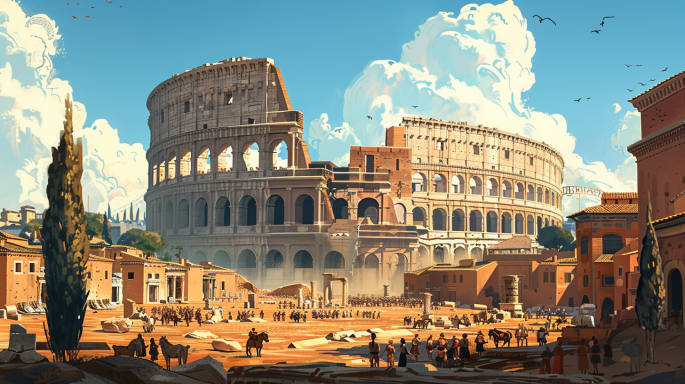Introduction
The marvel of ancient Roman architecture is evident in the numerous structures that have withstood the test of time. From the majestic Pantheon with its unreinforced concrete dome to the Colosseum that has weathered centuries, these edifices are a testament to the advanced engineering skills of the Romans. The secret to their longevity lies in the unique composition of Roman concrete. Unlike modern concrete, which often degrades over a few decades, Roman concrete has remained durable for over two millennia. The key to this remarkable durability is volcanic ash.
Discovery of Roman Concrete
Historical Background
The use of concrete by the Romans dates back to around 300 BCE. They referred to their concrete as “opus caementicium,” a mix of lime, water, and aggregates. The Romans were master builders who utilized this material extensively in their construction projects.
Importance in Roman Architecture
Roman concrete was crucial for the construction of their vast infrastructure, including aqueducts, bridges, harbors, and buildings. Its ability to set underwater made it indispensable for marine structures, allowing the Romans to expand their empire and trade networks.
Composition of Roman Concrete
Basic Ingredients
The primary components of Roman concrete include lime (calcium oxide), volcanic ash (pozzolana), and water. Aggregate materials like pieces of rock, ceramic, and brick were also mixed in.
Volcanic Ash: The Secret Ingredient
Volcanic ash, particularly from the region around Mount Vesuvius, played a pivotal role in the strength and durability of Roman concrete. This ash contains silicate and alumina, which react with lime and water to form a strong, stable binder.
The Chemistry Behind the Strength
Pozzolanic Reaction
The pozzolanic reaction occurs when volcanic ash reacts with lime in the presence of water. This reaction produces a dense, durable binder that enhances the concrete’s strength and longevity. The chemical process involves the formation of calcium-aluminum-silicate-hydrate (C-A-S-H), which binds the aggregate materials together more effectively than the products of modern Portland cement.
Advantages Over Modern Concrete
Modern concrete primarily uses Portland cement as a binder, which does not possess the same long-term durability as Roman concrete. The pozzolanic reaction in Roman concrete reduces the size and connectivity of pores in the material, making it less susceptible to cracking and environmental damage.
Applications in Roman Engineering
Marine Structures
One of the most impressive uses of Roman concrete was in marine structures, such as the harbors of Portus and Cosa. The ability of Roman concrete to harden underwater made it ideal for constructing durable and stable foundations for docks and piers.
Monumental Buildings
The Pantheon, with its massive concrete dome, and the Colosseum are prime examples of the enduring strength of Roman concrete. These structures have survived numerous earthquakes and environmental challenges over the centuries, largely due to the resilient properties of their construction materials.
Modern Rediscovery and Studies
Research and Analysis
Recent scientific studies have employed advanced techniques such as X-ray diffraction and electron microscopy to analyze the composition of Roman concrete. These studies have confirmed the presence of volcanic ash and its crucial role in the material’s durability.
Lessons for Modern Construction
Understanding the composition and chemistry of Roman concrete has significant implications for modern construction. Incorporating pozzolanic materials in concrete mixtures could enhance the longevity and sustainability of contemporary structures.
Conclusion
The enduring strength of Roman concrete is a remarkable achievement of ancient engineering. The secret ingredient, volcanic ash, facilitated a chemical reaction that produced a resilient and long-lasting material. By studying and applying these ancient techniques, modern construction can benefit from the lessons of the past, creating structures that stand the test of time.
FAQs
1. What makes Roman concrete different from modern concrete?
Roman concrete incorporates volcanic ash, which reacts with lime to form a durable binder. This makes it more resilient and longer-lasting than modern concrete, which primarily uses Portland cement.
2. How did the Romans use volcanic ash in their concrete?
The Romans mixed volcanic ash with lime and water to create a pozzolanic reaction. This reaction produced a strong, stable binder that enhanced the concrete’s durability.
3. Why is Roman concrete more durable than modern concrete?
The pozzolanic reaction in Roman concrete reduces the size and connectivity of pores, making it less prone to cracking and environmental damage. This results in greater long-term durability.
4. Can modern construction benefit from the use of volcanic ash?
Yes, incorporating pozzolanic materials like volcanic ash into modern concrete mixtures can enhance their durability and sustainability, potentially leading to longer-lasting structures.
5. What are some examples of structures built with Roman concrete?
Notable examples include the Pantheon, with its massive concrete dome, and the Colosseum. These structures have survived for over two millennia, showcasing the remarkable durability of Roman concrete.

